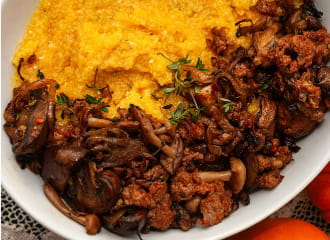- Prediabetes Mastermind
- Posts
- How cooking methods affect blood sugar
How cooking methods affect blood sugar
Prep tips for prediabetes
Welcome back, health champions!👋
Quick question: Have you been watching those TikTok videos that make you anxious about lectins, phytates, and oxalates in beans, lentils, grains, and nuts?
Have you come across wellness influencers making you question if your grilled chicken habit is secretly sabotaging your glucose?
Today's Health Guide tackles the nuanced stuff: how prediabetes cooking methods actually matter. We're talking simple kitchen swaps - soaking, marinating, choosing your pot over your grill.
No food fear. No complicated protocols. Just practical tweaks that move the needle.
BEST FINDS
Celebrate autumn with these blood-sugar-friendly recipes that deliver seasonal comfort without the spike: Cider-Braised Chicken Thighs With Apples and Greens balances fruit sweetness with lean protein and fiber-rich greens, while Sheet Pan Tempeh and Fall Vegetables offers plant-based protein with minimal prep. Pumpkin Polenta with Mushrooms and Sausage brings cozy comfort—keep portions modest and load up on the vegetables. Crab, Kale & Ricotta Lasagna Rolls with Parmesan Pumpkin Sauce transforms pasta night into a protein-packed meal, while Vegan Lentil Meatloaf satisfies with fiber-rich lentils. Finish with Healthy Apple Crisp with Oats and Almond Flour, where smart swaps add protein and fiber—serve with Greek yogurt for extra staying power.
Prediabetes Cooking: Plants, Meat & Dairy
Small prep tweaks, better numbers
Remember Part 1, where we tackled ultra-processed foods and food sequencing? Those changes alone can reduce glucose spikes by 30-40%. So why Part 2?
Because you still have questions about prediabetes meal planning.
Are beans actually okay despite the "antinutrients" discussed online?
Does grilling your chicken mess with your glucose?
Should dairy's insulin response worry you?
The Balanced Approach to Prediabetes Meals
Here's the deal: Plants contain compounds with both benefits and drawbacks—cooking changes everything. Meat and dairy effects depend on the cut, preparation, portion size, and your individual lab results.
Your navigation tools: glucose meter or CGM, satiety levels, and digestive comfort. Let's separate what matters from what you can ignore.
Plant "Antinutrients" - Clear, Calm, Practical
The term "antinutrient" sounds alarming. It's not.
These are simply plant compounds that can affect mineral absorption or digestion. Most are easily managed with proper prediabetes cooking, and many offer genuine health benefits.
Phytates (Mixed evidence)
Found in whole grains, legumes, nuts, and seeds. Yes, they can bind to minerals like iron and zinc, reducing absorption. But—plot twist—they also act as antioxidants and may actually help with blood sugar control.
The fix? Soak your beans, grains, and nuts for 8-12 hours before cooking. Or try sprouting them. Sourdough fermentation works too. You get the nutritional benefits without the mineral-binding effects.
Oxalates (Mixed evidence)
High levels show up in spinach, beet greens, Swiss chard, and almonds. For most people, oxalates pose zero problems. If you're prone to kidney stones, they matter.
The solution: Boil or blanch high-oxalate greens and drain the water—this removes 30-90% of oxalates. Rotate your greens: mix in romaine, arugula, and kale instead of only spinach. Eating calcium-rich foods with oxalate foods helps bind oxalates in your gut.
Lectins (Mixed evidence)
Present in legumes and grains. Raw or undercooked lectins can cause digestive distress. Good news: pressure cooking or boiling fully deactivates them.
Properly cooked beans and lentils actually improve glucose control thanks to their fiber and resistant starch (Strong evidence). Key word: properly cooked.
Polyphenols and tannins (Often helpful)
Found in tea, coffee, berries, and colored vegetables. These compounds modestly slow carbohydrate absorption—generally a benefit for glucose management. Don't worry about these.
Goitrogens (Emerging/Contextual)
Raw cruciferous vegetables (broccoli, cauliflower, cabbage, kale) contain compounds that can theoretically interfere with thyroid function. Cooking largely deactivates them.
This only matters if you have iodine deficiency or existing thyroid issues. For most people, these vegetables are protective.
Your action card: Soak → Rinse → Cook. Add sprouting or fermenting when you have time.
How do you usually cook your proteins? |
Meat & Dairy in Prediabetes Meals
The conversation around meat and dairy for prediabetes meal planning is nuanced. Let's focus on what the evidence supports.
Saturated fat patterns (Mixed evidence)
Diets very high in saturated fat may impair insulin sensitivity in some people, though responses vary. Balance fatty cuts of red meat with fish, poultry, and plant-based fats in your prediabetes meals. Include fatty fish 2-3 times weekly for omega-3s.
Heme iron (Mixed evidence)
The iron in red meat is highly absorbable—helpful if you're deficient. However, elevated iron stores (ferritin) have been associated with insulin resistance. Avoid unnecessary iron supplementation unless diagnosed with deficiency. Consider getting ferritin checked if you eat red meat daily and have prediabetes.
Advanced glycation end-products—AGEs (Emerging/Mixed evidence)
These compounds form when proteins and fats hit high, dry heat—grilling, broiling, frying. Higher AGE intake may contribute to inflammation and insulin resistance. This is where prediabetes cooking methods really matter: favor stewing, braising, poaching, or slow-cooking for 2-3 meals per week. When you grill, marinate first in something acidic.
Dairy's insulin response (Mixed evidence)
Dairy, especially whey protein in milk and yogurt, can trigger significant insulin release. Surprisingly, this often improves overall glucose control through enhanced satiety. Fermented, unsweetened dairy (Greek yogurt, kefir) tends to be glucose-friendly. Test your response.
TMAO precursors (Emerging evidence)
Certain compounds in red meat can be converted by gut bacteria into TMAO, which may increase cardiovascular risk. A sensible approach: rotate in fish and pair meat with fiber-rich vegetables to support beneficial gut bacteria.
Prediabetes Cooking Tactics That Preserve Benefits and Minimize Risk
Smart preparation methods can transform how foods affect your blood sugar:
Legumes, grains, and starches
Soak overnight, cook thoroughly, then cool in the refrigerator before reheating. This cooling creates resistant starch that behaves like fiber and produces smaller glucose spikes (Strong evidence). This works for rice, potatoes, and pasta too.
Leafy greens and nuts
Boil high-oxalate greens for 3-5 minutes, then drain. Rotate your nuts and seeds, soaking them before eating or choosing sprouted versions to reduce phytates.
Meats
Marinate for at least 30 minutes in acidic mixtures—lemon juice, yogurt, vinegar, or wine with herbs—to reduce harmful AGE formation by up to 50%. When grilling, limit char and avoid blackened bits.
Dairy
Choose plain Greek yogurt or kefir, adding your own berries, nuts, or minimal honey. Test your personal tolerance with your meter.
The key principles: Properly prepared legumes and intact whole grains support healthy glucose management through their fiber and resistant starch (Strong evidence). Fermented foods like yogurt, kefir, tempeh, and true sourdough can improve glucose tolerance. Finally, rotation beats restriction—variety in protein sources, cooking methods, and plant foods supports both metabolic health and nutritional completeness.
Smart Pairing for Prediabetes Meals
Everything from Part 1 carries forward: vegetables first with acidic dressing, protein with every starch, adequate fiber, and post-meal movement. These strategies work synergistically with today's prep methods.
Troubleshooting & When to Get Help
Experiencing repeated glucose spikes from a specific food? Change your prep method before cutting it entirely. That beef might work beautifully stewed even if it spikes you grilled.
Get professional guidance for: history of kidney stones (oxalate management), elevated ferritin (heme iron intake), or persistent digestive distress with well-cooked legumes. Work with your healthcare provider or a registered dietitian who understands metabolic health and prediabetes meal planning.
Have questions? We got answers. Email [email protected]

How did you like today’s newsletter? |

THAT’S A WRAP
[All original research data maintained but served with extra care ✨]
Here's to your health,
Swapneeta and Ava
from Prediabetes Mastermind





